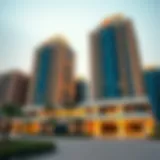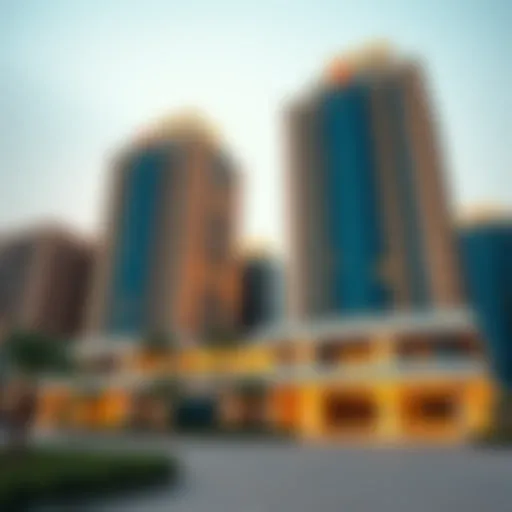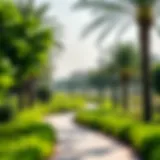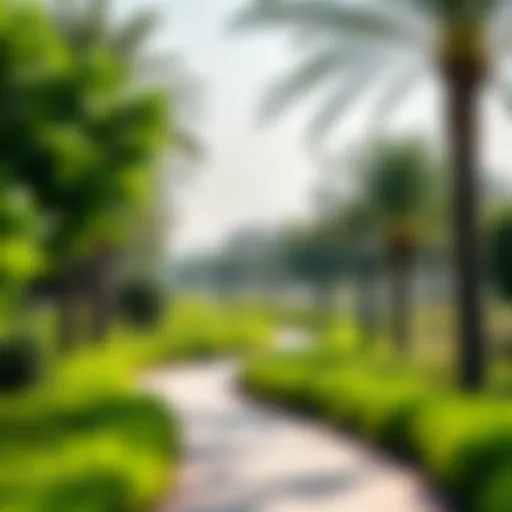Master Developers and Their Impact on Dubai's Real Estate
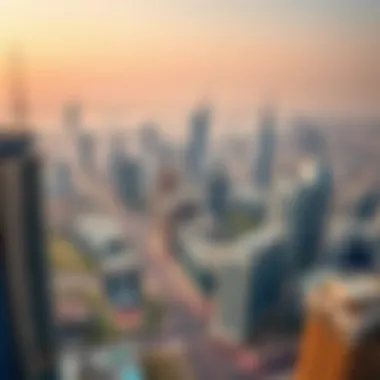
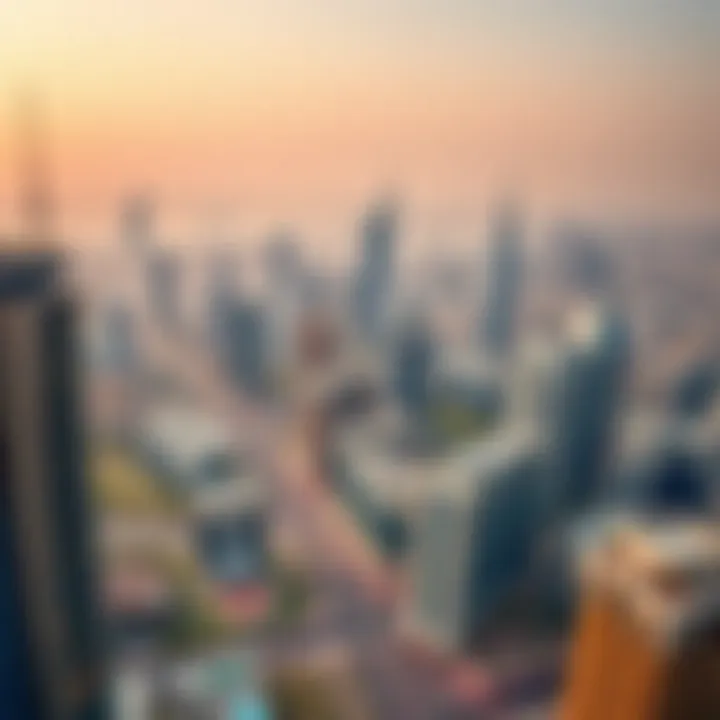
Intro
The real estate market in Dubai has always been a conversation starter, attracting investors and home seekers from all corners of the globe. Central to this vibrant dynamic are master developers, who not only shape the skyline with their ambitious projects but also steer the course of urban development and infrastructure growth. As the beating heart of Dubai’s real estate sector, these entities wield considerable influence over market trends, offering diverse opportunities that appeal to investors and homeowners alike. In this article, we shall peel back the layers to uncover the essential role that master developers play, how they create environments that inspire living and working, and the implications this has for all stakeholders within the bustling property market.
Market Trends
Current Real Estate Trends in Dubai
Dubai’s real estate landscape is currently undergoing remarkable transformation. The infusion of smart city initiatives, sustainability efforts, and mega projects is shifting the paradigm. Investors are closely watching how Cityland Mall and Dubai Creek Harbor integrate leisure with residential living, providing a modern twist to urban development. The continuous influx of expatriates is also driving demand for well-planned communities, leading to richer choices in property types.
The mid-range and affordable housing segments are witnessing notable activity, largely fueled by government incentives aimed at middle-class families. Properties like Al Furjan and Dubai South appeal to those seeking value without compromising on quality. Additionally, the short-term rental market shows promise, thanks to platforms like Airbnb, indicating a shift in consumer preferences.
Future Forecasts for the Dubai Property Market
Looking ahead, the future of Dubai’s property market seems bright. Analysts project that the next few years may see an uptick in prices, particularly with Expo 2020 concluding. The attention brought by this global event is fostering interests that could lead to sustainable increases in property valuation. However, caution is warranted, as the potential for oversupply looms, especially in luxury segments where many projects have been announced.
According to research by Knight Frank, the ongoing developments in sectors like hospitality and mixed-use communities will likely advance, countering speculation surrounding a potential downturn. Furthermore, with the UAE’s strategic shift towards ech innovation, the integration of technology in real estate will likely redefine tenant experiences and operating efficiencies across developments.
"As master developers innovate and expand, the real estate market in Dubai could witness a shift towards more inclusive and accessible living options." – Knight Frank Report 2023
Property Types
Residential Properties: Overview and Insights
Residential properties in Dubai are a mixed bag of luxurious villas, high-rise apartments, and affordable housing units. For instance, communities like DAMAC Hills encapsulate luxury with golf course views, while other developments, such as Dubai Marina, offer vibrant city life amidst stunning waterfront vistas. The variety in residential offerings reflects not just an aesthetic choice, but a strategic response to resident preferences and market demands.
What’s more, co-living spaces are also on the rise. These modern solutions tap into community living trends, appealing particularly to millennials and young professionals who favor a lifestyle that prioritizes flexibility and social engagement. This market segment presents unique opportunities for investors, aligning well with broader global trends in housing.
Commercial Properties: Opportunities and Challenges
On the commercial side, Dubai’s real estate market is a mixed landscape of opportunities and hurdles. The demand for office spaces is balancing between traditional businesses and agile workspaces. Major developments such as One Za'abeel cater to multinational companies, while start-ups find homes in shared workspaces, adapting to a flexible business climate.
However, challenges abound. The rapid evolution in work culture due to technology and recent shifts towards remote working mean that traditional office property might face undersupply. Furthermore, with the increased awareness around sustainability, new regulations could soon reshape what commercial buildings must adhere to, pushing developers to adapt quickly.
Understanding Master Developers
In the intricate tapestry of Dubai's real estate market, master developers hold a pivotal position. They are not just builders; they are visionaries who shape the urban landscape of the city. Understanding their role and significance is crucial for anyone looking to engage with the property market, whether as an investor, homebuyer, or industry professional. Their decisions influence everything from project design to environmental sustainability, thus impacting the broader economic framework of Dubai itself.
Definition and Role
Master developers are entities responsible for planning, managing, and executing large-scale urban developments. They wield authority over significant portions of land and are tasked with coordinating various infrastructure components to facilitate cohesive growth. Essentially, they streamline the development process, ensuring that different projects are not only built efficiently but also integrated into the wider urban ecosystem.
To put it simply, they are akin to conductors of an orchestra. Each instrument - or in this case, development project - must harmonize to create a well-rounded environment.
- Urban Planning: They determine land usage, zoning regulations, and the overall design of developments.
- Infrastructure Development: Managing roads, utilities, and public facilities is in their wheelhouse.
- Community Engagement: They often seek feedback from residents and stakeholders to enhance project outcomes.
- Sustainability: It's become more essential now for developers to incorporate green practices in their projects, which are increasingly becoming a requirement for urban living.
Historical Context
The role of master developers in Dubai didn’t emerge overnight. Instead, it represents a response to the city’s rapid transformation from a modest trading post into a bustling metropolis. The late 20th century saw the discovery of oil, leading to an influx of wealth and a surge in population. Consequently, there was a desperate need for structured planning and development.
In the early years, the government took the lead in development projects. However, as conditions evolved, private enterprises began to step in, fostering a more collaborative environment in which government and private entities co-existed to champion urban growth. The introduction of large-scale developers, such as Emaar and Nakheel, marked a paradigm shift, emphasizing luxury living and iconic landmarks that defined the skyline.
Over the years, the role has continued to evolve with advancements in technology, changing investor preferences, and a push for sustainability. Today's master developers deal with challenges like market saturation and ever-evolving regulatory landscapes, and they must adapt to remain relevant in this quickly shifting environment.
Key Players in Dubai's Development
In the grand tapestry of Dubai’s real estate landscape, master developers serve as the pivotal thread, weaving together various elements of urban development. Their influence shapes the skyline and gives rise to vibrant communities. Understanding these key players is not just for industry insiders, but for anyone keen on investing in Dubai's property market.
Notable Master Developers
The landscape of Dubai's real estate is not devoid of giants; three notable names often come to the forefront. Each of these developers plays a crucial role, making substantial contributions to the growth and identity of the city.
Emaar Properties
Emaar Properties shines brightly as one of the most recognized names in Dubai’s development scene. Known primarily for its breathtaking contributions, such as the iconic Burj Khalifa, Emaar has set a benchmark that other developers aspire to reach. The company is particularly noted for its focus on luxury and modern living spaces that cater to an upscale clientele.
One key characteristic of Emaar is its diverse portfolio, which includes a mix of residential, commercial, and leisure properties. This makes it a popular choice among investors looking to tap into various sectors of the market. The unique selling point of Emaar lies in its commitment to creating not just buildings but comprehensive lifestyles. Their developments often come attached with amenities such as parks, retail centers, and community hubs, creating a well-rounded living experience.
However, its focus on premium projects can sometimes put ownership out of reach for lower-income buyers, raising questions about affordability. As a result, while Emaar Properties stands as a pillar of luxury, it also illustrates the challenges of balancing exclusivity with accessibility in a rapidly developing market.
Nakheel
Nakheel is another heavyweight in the industry, known for its ambitious projects that push the boundaries of architectural innovation. Their most famous creation, the Palm Jumeirah, is a testament to visionary planning that has not only transformed the coast but has also become an emblem of Dubai itself.
A notable aspect of Nakheel’s strategy is its emphasis on large-scale developments that integrate residential, commercial, and recreational areas. This holistic approach is a major benefit as it fosters community living while also attracting both tourists and residents alike. Nakheel has also made strides in sustainability with projects like the Dragon Mart and various eco-friendly community initiatives.
Nonetheless, Nakheel has had its share of challenges, particularly during economic downturns, which have sometimes affected the pace and timing of their projects. Balancing grand ambitions with economic realities remains a critical aspect of Nakheel's ongoing narrative in the marketplace.
Dubai Holding
Dubai Holding embodies a multifaceted approach to development, operating across numerous sectors beyond real estate, including hospitality and telecommunications. This diverse portfolio enables it to leverage synergies across industries, ensuring a comprehensive impact on urban infrastructure.
A key characteristic of Dubai Holding is its strategic investments in iconic projects such as the Dubai Design District and various luxury hotels. This makes it a beneficial player's for anyone wanting to understand the multifaceted nature of Dubai's development ecosystem. Dubai Holding aims to enhance Dubai's global standing as a cultural and business hub.
On the downside, its broad scope might lead to a diluted focus on individual projects, sometimes impacting the unique characteristics that differentiate them. Investors must consider whether the overall vision aligns with their specific interests in property.
Emerging Firms
Beyond the established names, the Dubai real estate market is witnessing a surge in emerging firms that are bringing fresh perspectives and innovation to the development scene. These companies often focus on niche markets or specialized areas of development, providing unique offerings that cater to specific segments of buyers.
Their growth is a testament to the dynamic nature of the industry, which encourages new ideas and approaches to real estate challenges. Investors should keep an eye on these firms as they can often present rewarding opportunities if they can successfully capture their target markets.
Major Developments Led by Master Developers
The essence of a city often lies in its buildings and infrastructure, and Dubai is no exception. Major developments led by master developers serve as the backbone of its urban landscape, reflecting not just architectural ambition but also the ambitions of the entire nation. These projects not only enhance the aesthetic appeal of the city but also contribute significantly to its economic and social fabric.
Master developers are pivotal in orchestrating these grand undertakings. They weave together various elements such as design, finance, project management, and marketing, ensuring that each development meets its objectives while adding value to the community. Let's delve deeper into some iconic projects and residential communities that highlight the transformative impact these developers have on Dubai.
Iconic Projects
Burj Khalifa
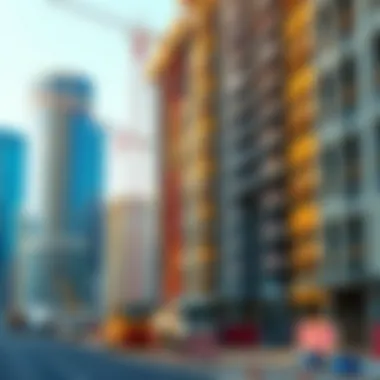
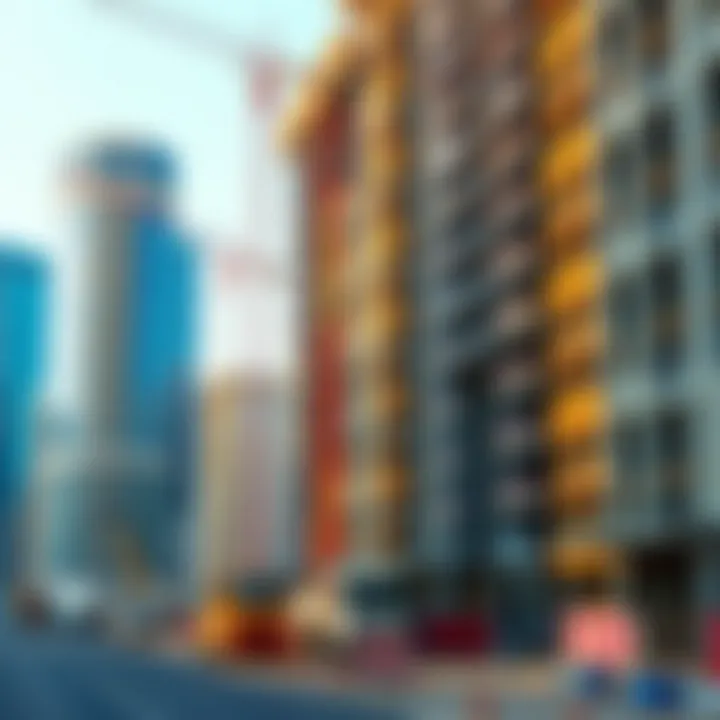
When one thinks of architectural landmarks, the Burj Khalifa inevitably comes to mind. Towering at 828 meters, it holds the title of the tallest building in the world. The Burj Khalifa is not merely a feat of engineering; it is a symbol of Dubai’s aspirations and its aggressive pursuit of innovation.
Notable for its unique design, influenced by Islamic architecture, it boasts a mixture of residential spaces, corporate suites, and observation decks. The breathtaking views from the observation deck are a major draw, making it a popular choice for tourists and locals alike. Moreover, its completion in 2010 marked a critical point in the global construction narrative, showcasing Dubai as a serious contender in high-rise development.
However, such grandeur comes with its challenges. The maintenance, energy consumption, and operational costs remain high. Despite these, the Burj Khalifa continues to be a vital contributor to Dubai’s economy, attracting visitors and enriching local businesses through its shops and restaurants.
Palm Jumeirah
Next, we turn our eyes to the Palm Jumeirah. This palm-shaped island has carved out a niche in luxury living. Stretching into the Persian Gulf, it is a testament to human creativity and engineering, featuring lavish villas, upscale hotels, and vibrant beach clubs.
The key characteristic of Palm Jumeirah is its ambitious design that transforms sea into land, creating a haven for both residents and tourists. Its unique feature lies in its never-seen-before layout, which resembles a palm tree, symbolizing growth and prosperity. Additionally, the island hosts some of the most coveted real estate in Dubai, effortlessly blending leisure with luxury.
However, challenges such as environmental impact and infrastructural congestion persist. The balance that developers must strike between luxury and ecological integrity is a matter of ongoing discussion.
Residential Communities
Dubai Marina
Moving from iconic structures to residential spaces, Dubai Marina stands out as a vibrant community that exemplifies modern urban living. This waterfront district is engineered for a lifestyle of convenience, featuring a plethora of restaurants, shops, and leisure activities, making it a sought-after locale for both expats and locals.
The key characteristic of Dubai Marina is its integrated living space that offers high-rise apartments with stunning views, accompanied by a bustling promenade along the water. This combination of residential and recreational facilities promotes a vibrant community vibe.
What sets it apart is the unique feature of a man-made marina, which not only boosts property desirability but also supports local tourism. On the flip side, the rapid development and increasing density raise concerns regarding congestion and infrastructure strain that need addressing as the area continues to grow.
Arabian Ranches
Lastly, Arabian Ranches presents a different yet equally appealing aspect of Dubai’s residential landscape. Catering to families seeking tranquility away from the bustle of city life, it provides spacious villas surrounded by greenery and lush landscaping.
The key characteristic here is its focus on community and lifestyle, enriched by amenities such as golf courses, equestrian centers, and recreational parks. This makes it not just a place to live, but a place to thrive.
One unique feature of Arabian Ranches is the sense of privacy and peacefulness it offers, making it a desirable choice for families. However, it can come with a trade-off in terms of accessibility, as the distance to commercial hubs might deter some potential residents.
"Major developments by master developers shape not only the skyline but also the life of the inhabitants, marrying luxury and functionality to create living spaces that inspire."
Impact on Dubai's Economy
The economic repercussions of master developers in Dubai's market cannot be overstated. These entities not only shape the skyline but also significantly influence the region's overall economic health. The dynamic nature of their projects leads to a cascade of effects, enhancing the city's appeal for investors and residents alike.
In essence, master developers serve as key players in bolstering Dubai's economy through two primary avenues: job creation and foreign direct investment. Each of these elements contributes to a thriving economic ecosystem that offers both stability and growth potential.
Job Creation
Master developers are often at the forefront of job creation in Dubai. When they embark on large-scale projects, they set off a chain reaction that generates employment opportunities throughout the construction and operational phases. It's not just about the jobs directly created on construction sites; the ripple effect extends far beyond. Skilled laborers, engineers, architects, and project managers all find abundant opportunities due to the extensive projects initiated by these firms.
For instance, firm like Emaar Properties employs thousands directly and indirectly through its numerous developments, such as the iconic Burj Khalifa. Here, the construction alone provided jobs for architects and laborers. Subsequently, as the buildings and communities complete, a multitude of roles arise in maintenance, management, and services to support the new residents. This ripple, in turn, strengthens the entire labor market in the region.
- The boost to the local economy through wages spent in the community.
- Creation of related businesses, from retail shops to hospitality ventures, catering to new residents.
Ultimately, the job opportunities catalyzed by master developers play a pivotal role in combating unemployment, promoting talent development, and enhancing the overall quality of life for residents.
Foreign Direct Investment
When master developers like Nakheel and Dubai Holding launch flagship projects, they attract not just local interest but foreign direct investment as well. These entities act as magnets for international investors, who are drawn to the promise of modern infrastructure and luxury lifestyle options.
Dubai’s reputation as a booming global hub is nurtured by these large-scale developments. Investors look to the innovations and ambitions showcased in projects such as the Palm Jumeirah and Dubai Marina as indicators of a potentially lucrative market.
This influx of foreign capital supports not merely the development process but also fuels numerous ancillary sectors, including tourism, retail, and services. Here’s how it typically plays out:
- Increased market confidence leads to more investments in various sectors, enhancing infrastructure.
- Development projects are not just facilities; they become integrated communities that invite partnerships with various international brands, thus diversifying the economic base.
- As investment flows in, there's a boost in the local currency, positively impacting the overall economy.
"The synergy between master developers and foreign investors creates a vibrant economy in Dubai, transforming it into a leading global player."
In summary, master developers in Dubai are more than just builders; they are vital to the economic framework. Through job creation and foreign investments, they are effectively sculpting an ever-evolving landscape, fostering growth and stability in both the real estate sector and the broader economy.
Regulatory Framework
The regulatory framework governing Dubai's real estate market plays a crucial role in ensuring a stable and conducive environment for investment and development. This framework encompasses a wide range of government policies, legal considerations, and regulations that not only protect investors but also facilitate smooth transactions and enhance market transparency.
Having a solid regulatory framework is essential for several reasons:
- Investor Confidence: A transparent and comprehensive set of regulations instills confidence among potential investors. They want to be assured that their investments are protected under the law.
- Market Stability: Consistent regulations prevent sudden market fluctuations and instabilities. This is particularly important in a rapidly evolving market like Dubai's, where master developers often engage in large-scale projects.
- Sustainable Growth: By enforcing regulations on development practices, the government promotes sustainable urban growth that aligns with the strategic vision for the emirate.
This framework is not static; it evolves in tandem with market needs and trends. In the following sections, we’ll explore the specific elements of this framework starting with government policies and moving into important legal considerations.
Government Policies
In recent years, Dubai's government has rolled out an array of policies aimed at bolstering the real estate market. These policies are designed to enhance economic growth while ensuring that development practices are sustainable and beneficial to the community.
One significant policy is the Dubai 2040 Urban Master Plan, which aims to enhance the quality of life for Dubai’s residents while meeting the growing demand for residential and commercial properties. By laying out clear guidelines for land utilization and infrastructure development, this policy aids master developers in aligning their projects with the broader vision of Dubai's growth.
Moreover, initiatives such as the Freehold Ownership Law allow foreign nationals to purchase property within designated areas. This policy creates equal opportunity for many potential homebuyers and investors, reflecting how legislative measures actively encourage diverse participation in the market.
Legal Considerations
Legal considerations are another fundamental aspect of the regulatory framework. They provide the backbone for protecting all parties involved in real estate transactions. Understanding these legal requirements is essential for both developers and buyers.
For instance, the Real Estate Regulatory Agency (RERA) oversees all real estate transactions in Dubai. RERA’s guidelines dictate how developers can sell properties, ensuring that they provide clear information about projects, fees, and delivery timelines. This legal oversight mitigates risks associated with misleading practices and protects consumer rights.
Furthermore, Dubai enforces strict laws against money laundering, ensuring that all real estate transactions are transparent and meet international standards. These legal frameworks not only safeguard buyers but also elevate Dubai’s reputation as a honorable business environment, attracting investors from around the globe.
"A robust regulatory framework isn’t just about rules and laws; it's about building trust in the marketplace and creating a conducive environment for all stakeholders to thrive."
Sustainability Initiatives
Sustainability initiatives are more than just current buzzwords in the realm of real estate; they are becoming essential components of modern development in Dubai. As the city continues to grow at a breakneck pace, master developers are stepping up to the plate, integrating sustainability into their projects to ensure a balance between urban advancement and environmental stewardship. The importance of this focus cannot be overstated as it not only addresses pressing environmental concerns but also enhances property values and promotes a healthier lifestyle for residents.
Sustainability in real estate encompasses a range of practices, from energy efficiency and waste reduction to water conservation and the use of sustainable materials. These elements contribute significantly to reducing the carbon footprint of developments, which is increasingly crucial in a climate-conscious world.
Green Building Standards
Green building standards are engineered frameworks that set the benchmarks for sustainable construction practices. In Dubai, the introduction and adherence to these standards have transformed the landscape, spurring master developers to design with a forward-thinking mindset. The Dubai Green Building Code, for instance, provides guidelines that encourage healthier living environments while maximizing energy efficiency.
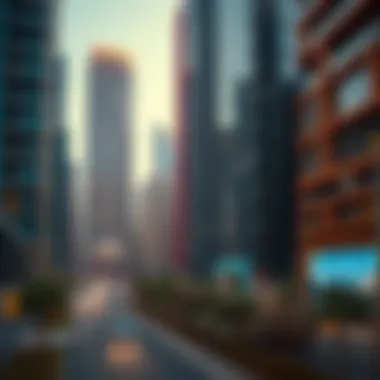

Significant benefits include:
- Energy savings: Buildings certified under green standards often use up to 30% less energy.
- Water conservation: Efficient plumbing and landscaping designs lead to an approximate 20% reduction in water use.
- Enhanced property values: Eco-friendly properties tend to attract higher interest from buyers and tenants.
Master developers like Emaar and Nakheel have adopted these standards in many of their flagship projects, resulting in accolades for both innovation and environmental responsibility. The implementation of solar panels, green roof installations, and the use of recycled materials are a few strategies that illustrate the shift toward greener construction.
Community Engagement
Community engagement forms another pillar of sustainability initiatives. Master developers are realizing that involving local communities in the planning and decision-making processes fosters a sense of ownership and responsibility towards their surroundings. Collaborative initiatives can include town hall meetings, feedback sessions, and interactive workshops aimed at gathering insights from residents about their needs and preferences.
The benefits of such engagement are manifold:
- Stronger community ties: Engaged residents are more likely to participate in community programs, enhancing neighborhood spirit.
- Tailored development: Insights from the community can lead to designs that better meet resident expectations, ultimately improving quality of life.
- Sustainable practices: Informed residents are more likely to adopt sustainable practices in their daily lives, aligning personal actions with broader development goals.
In recent years, various developments in Dubai have incorporated community gardens, recreational spaces, and mixed-use facilities based on resident feedback, making them not just places to live but thriving hubs of activity and interaction.
These sustainability initiatives are not merely optional; they are becoming prerequisites for success in Dubai's real estate market. By embracing green building standards and fostering community engagement, master developers are not only enhancing their reputation but are also laying the groundwork for a resilient and sustainable urban environment.
Market Trends and Insights
In the ever-evolving landscape of Dubai's real estate sector, market trends and insights play a pivotal role in determining the strategic direction for both investors and developers. Understanding these trends means grasping how the market responds to economic stimuli, demographic shifts, and the policies implemented by master developers. As the real estate dynamics can change faster than a desert wind, keeping a close eye on these nuances becomes essential for making informed decisions.
Current Market Dynamics
The current market situation in Dubai is markedly influenced by a variety of factors, from global economic conditions to local government initiatives. Currently, there is a noticeable surge in luxury residences that cater to a wealthy clientele, largely driven by the influx of expatriates and foreign investors. This segment continues to flourish despite the broader economic fluctuations observed internationally.
- Supply and demand: The equilibrium in the housing market is increasingly being disrupted by high demand for upscale properties. Areas like Dubai Marina and Downtown Dubai are witnessing a substantial amount of property being snapped up, creating a competitive atmosphere that boosts prices.
- Investment trends: Investors now find themselves gravitating toward mixed-use developments, where residential, commercial, and leisure spaces converge. This trend helps to enhance community living, turning neighborhoods into vibrant ecosystems.
"Master developers are rethinking traditional boundaries by integrating various conveniences into a single project, enhancing attractiveness to potential buyers and investors."
- Technology's role: Technology is reshaping consumer expectations, with a rising demand for smart homes and sustainable building practices. Buyers are looking for properties equipped with the latest technological advancements, from smart energy systems to integrated home automation.
Future Projections
As for the future, several trends manifest that are likely to influence the trajectory of Dubai's real estate market.
- Increased sustainability: Going forward, expect more emphasis on sustainability. Master developers are projected to adopt greener practices, integrating eco-friendly materials and designs into new projects. Tailored sustainability regulations may come from the government as part of its larger vision for a greener Dubai.
- Technological advancement: The role of technology will expand, with developments in AI and data analytics shaping customer interactions and project management. Predictive analytics could offer insights into future buying trends, benefitting developers in their strategic planning.
- Urban re-examination: Communities may see a transformation of existing areas as urban renewal initiatives gain traction. This could lead to redevelopment in older neighborhoods where historical preservation meets modern living standards.
- Global investment shifts: The potential for changing geopolitical landscapes could redirect investment flows toward Dubai. As typical global hubs experience volatility, Dubai's stable and attractive climate for property ownership may draw even more international interest.
The interplay of these elements paints a vivid picture of a robust Dubai real estate market, one that is adaptable to trends while keeping sustainability and innovation at its core. This intricate interplay of current dynamics and future projections serves as a compass for anyone looking to dive into real estate happenings in this vibrant city.
For further reading on the influences shaping Dubai's real estate market, explore resources like Wikipedia or Britannica.
Challenges Faced by Master Developers
Master developers play a pivotal role in shaping Dubai's real estate landscape, yet they do not have it all their way. The industry is rife with challenges that can complicate their efforts. Understanding these challenges is essential for stakeholders including investors, homebuyers, agents, analysts, and developers, as they navigate the intricate fabric of this vibrant market. Delving into key challenges such as market saturation and regulatory hurdles provides valuable insights into how these factors can impact development strategies and overall success.
Market Saturation
In real estate, market saturation can become a double-edged sword. On one hand, it signals robust growth and opportunity; on the other, it can lead to oversupply. Dubai’s real estate market has seen a frenetic pace of development, especially following the 2008 financial crisis. The influx of new projects in popular areas may capture buyers' attention at first, but the sheer competition can dilute demand.
For example, the rapid development of clusters such as Dubai Marina and Downtown Dubai has introduced numerous residential units. If these areas become saturated, master developers must creatively differentiate their projects to maintain appeal. They must consider unique selling points, striking architectural design, or community features that can reignite interest in purchasing.
Master developers are constantly keeping an ear to the ground, analyzing shifts in consumer preferences and adjusting their portfolio accordingly. It's a strategic game of chess where predicting the right moves can mean the difference between success and failure.
Regulatory Hurdles
Navigating the regulatory landscape is another sticky wicket for master developers. Policies and regulations in Dubai can shift, influenced by economic factors and government strategies. Developers must stay compliant with local laws while also adapting to new frameworks that can evolve quite quickly. For instance, recent amendments in foreign ownership laws can create fresh opportunities but also come with layers of complexities that need careful management.
Moreover, failure to adhere to regulations can not only result in hefty fines but also derail projects entirely. For example, if a project does not meet the stringent environmental standards set by the Dubai government, it can result in delays and additional costs, severely affecting timelines and budgets.
"Master developers must operate like a ship navigating turbulent waters, constantly adjusting their sails to maintain course amid ever-changing regulations."
In summary, while master developers are at the forefront of Dubai's flashy real estate market, they often face significant challenges such as market saturation and a complex regulatory environment. Successfully addressing these issues requires a blend of foresight, strategic planning, and adaptability.
Role of Technology in Development
The integration of technology in real estate development is not just a luxury, but a necessity in the rapidly evolving landscape of Dubai's property market. Master developers have recognized the potential of technology to revolutionize not only the construction process but also the very way urban spaces are designed, built, and managed. This section discusses the relevance of technology, focusing on digital transformation and smart city initiatives. By leveraging these advancements, developers can create more efficient, sustainable, and user-friendly environments, ultimately benefiting investors, homebuyers, and the community as a whole.
Digital Transformation
Digital transformation in real estate refers to the application of advanced technologies to strengthen various facets of property development and management. This can range from using Building Information Modeling (BIM) to improve architectural visualization to employing artificial intelligence (AI) for predictive analytics.
In the context of Dubai, the demand for transparency and efficiency in real estate transactions has led many master developers to embrace digital tools. For instance, Emaar Properties has invested heavily in IT infrastructure, enabling clients to navigate the purchasing journey seamlessly via online platforms. This shift not only streamlines processes but also provides real-time data analytics to inform development strategies.
Benefits of digital transformation include:
- Enhanced Project Management: Technology tools help in tracking timelines, budgets, and resources, ensuring projects stay on course.
- Improved Customer Experience: Online portfolios and virtual tours make properties accessible to potential buyers, making the decision-making process smoother.
- Data-Driven Decisions: The ability to gather and analyze data leads to more informed decisions regarding investment, marketing, and development.
As the market becomes increasingly competitive, those developers that leverage digital transformation will likely stand out. Technology is more than just a shiny new toy; it forms the backbone of successful developments that meet the needs of modern consumers.
Smart City Initiatives
Dubai's master developers are not shying away from the concept of building smart cities – urban environments that utilize digital technology to enhance performance and well-being. These initiatives often intertwine with sustainability efforts, allowing developments to be both smart and green.
For instance, Nakheel has embarked on the development of integrated communities that incorporate smart technologies. These neighborhoods utilize Internet of Things (IoT) devices for everything from traffic management to energy conservation. An example is the smart meters installed in residential areas, which help track energy consumption and encourage residents to reduce waste.
Key components of smart city initiatives include:
- Connectivity: High-speed internet and networks allow seamless communication between devices, which is essential for urban management systems.
- Intelligent Infrastructure: Buildings equipped with smart technology, such as automated lighting and climate controls, reduce energy usage while enhancing living comfort.
- Safety and Security: Advanced surveillance systems and emergency response frameworks boost the safety of urban spaces.
As Dubai continues to grow, the investment in smart city projects reflects a forward-thinking approach. This not only attracts international stakeholders but assures residents that they live in a place where innovation thrives.
"Technology is reshaping urban landscapes, and Dubai stands at the forefront of this transformation, weaving digital solutions into the fabric of its developments."
The synthesis of technology with traditional development practices allows master developers to create a uniquely responsive and modern real estate market. Those who are willing to adapt and innovatively use these tools will define the future of Dubai's real estate landscape.
Real Estate Investment Strategies
In the ever-evolving landscape of Dubai's real estate market, implementing effective investment strategies is essential for stakeholders ranging from individual homeowners to seasoned investors. The significance of strategic planning cannot be overstated; it serves as the cornerstone for navigating the intricacies of a market that is as dynamic as it is competitive. Real estate investment strategies act as a guiding light, shedding clarity on crucial factors such as location evaluation, risk management, and market trends. By employing these strategies, investors not only enhance their chances of success but also align their investments with the broader economic objectives of Dubai's development.
Evaluating Locations


When it comes to real estate, the phrase "location, location, location" holds ever true. Evaluating the right locations can make the difference between a fruitful investment and a glaring misstep. In Dubai, this process is multifaceted and requires careful consideration of several factors:
- Infrastructure Development: Areas with robust infrastructure are often more appealing to buyers, as they offer convenience and accessibility. Observing upcoming projects can provide insights into future hotspots.
- Market Dynamics: Understanding current demand and supply dynamics in various neighborhoods allows investors to make informed decisions. For example, areas like Dubai Marina continue to attract buyers due to their ambiance and facilities, while emerging locales might be undervalued yet brimming with potential.
- Government Initiatives: The government's focus on certain areas for development can signal growth. Taking note of organizational efforts such as new transportation links or community projects can help in identifying potential high-yield investments.
- Cultural and Social Relevance: Areas that blend cultural heritage with modern amenities tend to resonate well with both local and expatriate communities. Such locations not only thrive in terms of real estate value but also contribute to a vibrant community identity.
It is suggested that investors perform thorough due diligence when evaluating potential areas for investment. This often means not just looking at the current market conditions but also envisioning how those areas might evolve in the future.
Risk Assessment
In every investment, risk is an inevitable companion. Successful investors distinguish themselves by their ability to identify, evaluate, and manage these risks effectively. In Dubai’s real estate sector, risk assessment encompasses several critical aspects:
- Market Volatility: The Dubai property market can be unpredictable, influenced by global economic factors, local regulations, and social trends. Investors need to be mindful of these fluctuations. Keeping an eye on market reports and analyses can help gauge potential shifts.
- Regulatory Risks: Understanding the legal landscape is crucial. Changes in property laws or visa policies can significantly impact the desirability of certain areas or investment types. Investors can mitigate this risk by staying informed about the latest regulations from official sources such as Dubai Land Department.
- Financial Considerations: Securing financing and understanding the terms of loans are essential steps. Evaluating interest rates and mortgage requirements before jumping into investment helps in making calculations that align with long-term financial goals.
- Market Saturation: The current trend towards oversupply in certain segments makes it all the more necessary to conduct comprehensive analyses before committing significant funds.
Investors should adopt a proactive approach to risk management, regularly reassessing their strategies based on market shifts.
In summary, real estate investment strategies in Dubai are more than just a checklist. They represent a holistic understanding of what makes the real estate market tick. As investors, whether seasoned or new to the field, the emphasis on location evaluation and risk assessment is paramount for making informed investment decisions that align with both current trends and future potentials. Understanding these elements is not merely beneficial but essential in turning investment aspirations into tangible successes.
Cultural Considerations in Development
When discussing the role of master developers within Dubai's real estate market, it’s crucial to address the cultural considerations that shape their projects. The mosaic of cultures and traditions in the UAE influences how developments are planned and constructed. Recognizing the cultural context is not merely a matter of aesthetics; it’s about understanding community needs and fostering a sense of belonging among residents.
Architectural Preservation
In a rapidly developing city like Dubai, architectural preservation stands out as a pivotal element. It refers to the practice of protecting buildings and sites that have historical and cultural significance. Master developers are increasingly recognizing the need to incorporate local architectural styles and heritage into their projects.
Benefits of Architectural Preservation:
- Cultural Significance: By preserving local architecture, developers can honor the history and traditions of the region, making their projects more relatable and meaningful to the inhabitants.
- Tourist Attraction: Structures that reflect traditional designs often attract tourists, thus benefiting the local economy. For example, developments like Bastakiya showcase Dubai’s rich heritage, drawing both visitors and potential residents.
- Community Support: Residents tend to support developments that respect and incorporate heritage. When new buildings harmonize with existing cultural landscapes, it fosters a sense of pride and acceptance.
Master developers can strengthen their brand reputation by committing to preservation efforts. This commitment piques the interest of buyers who prioritize cultural heritage, subsequently enhancing demand.
Community Identity
Community identity encapsulates the shared values, beliefs, and traits that distinguish a group of people. For master developers, cultivating a strong community identity is essential for the long-term success of their projects. It can mean more than just physical space—it's about creating environments where individuals feel connected.
Considerations for Strengthening Community Identity:
- Local Collaboration: Engaging local artists, historians, and community leaders in development projects can help ensure that the community’s voice is both heard and reflected in the design process.
- Public Spaces: Incorporating parks, squares, and recreational facilities into developments encourages social interaction among residents. Well-designed public spaces can serve as cultural hubs, nurturing community ties.
- Cultural Events: Organizing events that celebrate local traditions and festivals within new developments can enhance community identity. This not only promotes unity among residents but also attracts visitors.
"The true essence of a community lies in its ability to weave its threads of culture into the very fabric of everyday life. Master developers have the opportunity to facilitate that weave."
To sum it up, paying attention to cultural considerations in development is not optional but a necessity. Master developers who align their practices with the unique cultural landscape of Dubai will likely find that they are not only building structures but fostering vibrant communities.
Consumer Preferences
Consumer preferences play a crucial role in shaping the architectural landscape and the overall approach of master developers in Dubai's real estate market. Understanding what potential buyers value can greatly influence project designs, marketing strategies, and even long-term investment decisions. It’s not just about providing housing; it’s about creating desirable living experiences.
Luxury vs. Affordability
Luxury and affordability are two sides of the same coin in this vibrant market. On one hand, you have the high-flying luxury segment. Buyers in this category are looking for opulent finishes, bespoke designs, and unique properties, often emphasizing the experience of living in a prestigious community. For instance, developments in areas like Downtown Dubai or the Palm Jumeirah have a distinct allure aimed at affluent buyers who are not just seeking a home but a status symbol.
In contrast, the affordable housing market caters to a different crowd - the working class, young families, or first-time homebuyers. This demographic tends to be more pragmatic, making decisions based on value and functionality. Communities such as Dubai South or International City have been designed with these considerations in mind, emphasizing adequate space, necessary amenities, and reasonable price points, offering a balance of comfort and cost-value.
In this competitive landscape, striking a balance between luxury and affordability isn’t just preferable—it’s essential for developers looking to maximize both sales and customer satisfaction.
Amenities and Services
When it comes to consumer preferences, amenities and services offered by residential developments are paramount. Today's buyers are not merely in the market for a roof over their heads; they seek a lifestyle that aligns with their aspirations.
From fitness centers, swimming pools, and parks to smart home technologies and concierge services, the variety of amenities shapes the appeal of a project.
- Health and Recreation: Buyers often skew towards properties that offer wellness-focused amenities such as gyms, cycling tracks, or yoga studios.
- Community Features: Outdoor spaces for families to gather, parks for kids to play, and even dog parks for pet owners can make a residential community feel comfortable and inviting.
- Convenience: Access to retail centers, public transport options, and schools can be dealmakers, especially in a bustling city like Dubai.
- Technological Integration: Smart homes that facilitate innovation and convenience resonate well with tech-savvy buyers, attracting a younger demographic looking for seamless living experiences.
"Consumer preferences aren't just a trend; they're a roadmap for the future of real estate development."
For further insights into these topics, you can refer to resources like Wikipedia, narrative strategies about consumer behavior on sites such as Britannica, and market discussions found on forums like Reddit.
The Future of Dubai's Real Estate Market
The landscape of Dubai's real estate market is continually evolving, making the discussion on its future both essential and timely. As master developers play a critical role in steering project initiatives, their strategies and insights directly impact the sustainability and growth trajectory of the market. Investors, homebuyers, agents, analysts, and developers alike need to be attuned to emerging patterns and potential risks, as these elements will influence opportunities in the terrain ahead.
Anticipated Trends
A peek into the future reveals a tapestry woven with several anticipated trends. The growth of smart city initiatives stands tall among them. With an eye towards modernization, many projects are expected to incorporate advanced technology for better urban management. This trend isn’t merely about flashy gadgets but rather the integration of systems that smartly manage resources like electricity and water. Consumers are leaning toward sustainability, too; the demand for green buildings is on the rise. Developers who can adapt to these eco-conscious preferences may find themselves at a prime advantage.
This trajectory also coincides with shifts in demographics and lifestyle preferences. Millennials and Gen Z are gravitating towards urban living with access to amenities. Developments that foster a sense of community, with parks, cafes, and recreational venues, will likely see increased interest.
In addition to lifestyle changes, market conditions are constantly oscillating. Speculation surrounding economic stability and housing demand is rampant. Factors such as interest rates, global economic shifts, and even political dynamics in the region can sway investment decisions significantly.
It’s clear: understanding these expected trends is paramount for anyone looking to navigate Dubai's property waters effectively.
Master Developer Strategies
As the architects of the urban design, master developers are adjusting their strategies to keep up with a fast-paced market. One emerging focal point is mixed-use development. By combining residential spaces with retail and leisure facilities, they’re not only maximizing available space but also enhancing community engagement. This approach fosters a more vibrant environment where people live, work, and play in a single locale – a trendy blueprint for future projects.
Moreover, master developers are placing a premium on innovative financing models. Crowdfunding and public-private partnerships are becoming tools for circumventing traditional financing hurdles. This flexibility allows for more diverse investment avenues, enabling smaller investors to enter the market alongside larger entities.
Regulatory compliance remains crucial, too. Adapting to evolving government policies while also advocating for streamlined regulations ensures that development projects can proceed unimpeded.
Another key strategy is placing an emphasis on sustainability. Developers are understanding the long-term benefits of eco-friendly initiatives. Energy-efficient designs and sustainable materials are not just seen as buzzwords; they are now integral in securing buyer interest and meeting regulatory requirements.
In summary, vigilant attention to anticipated trends coupled with proactivity in strategic planning can provide a roadmap for success in Dubai's ever-changing real estate domain. Those who keep their finger on the pulse of this sector may well uncover golden opportunities just waiting to be seized.
Ending
In this article, we've explored the transformative impact of master developers on Dubai’s real estate sector. It's crucial to realize that these entities do not merely build structures; they shape the very fabric of urban life. The master developers' role touches various aspects, from infrastructure enhancement to regulatory navigation, which collectively drive the economy forward.
Recap of Key Insights
Through various sections, we highlighted key insights:
- Role and Influence: Master developers such as Emaar Properties and Nakheel are central to the development of landmark projects like Burj Khalifa and Palm Jumeirah. Their vision defines the architectural landscape of modern Dubai.
- Economic Contributions: The participation of these firms is vital in creating jobs and attracting foreign direct investment. Their projects inject liquidity into the market and help stabilize economic fluctuations.
- Sustainability and Technology: Moving forward, the emphasis on green building standards and smart city innovations will shape future developments while meeting the expectations of a more environmentally conscious society.
- Regulatory Landscape: Understanding government policies and legal frameworks ensures that investors and developers navigate the market successfully, keeping compliance at the forefront of their operations.
These elements combine to illustrate the significance of master developers not just in milestone projects but also in fostering community identity and enhancing living standards within the metropolitan fabric.
Final Thoughts
Looking ahead, the role of master developers will only grow as Dubai positions itself as a global hub. The ongoing trends towards sustainability, technological integration, and community engagement are not only buzzwords but also pivotal to maintaining Dubai’s status in the international real estate arena.
For investors, understanding the dynamics of master developers can uncover lucrative opportunities. Homebuyers can benefit from insights into emerging neighborhoods shaped by these key players. Agents and analysts, too, play a crucial role in bridging the gap between developers and potential clients, necessitating a deep understanding of the market's evolving narrative.
As the saying goes, "the best time to plant a tree was twenty years ago, the second best time is now." Engaging with Dubai's real estate landscape can yield fruitful returns, provided the engagement is informed and strategic. Hence, to stay ahead in this vibrant market, one must continue to fuel their knowledge and adapt with the flow of changes.
"In the world of real estate, knowledge isn't just power; it's a key to unlocking potential."
As the dust settles on many developments, it becomes apparent that the contributions of master developers will echo throughout the city, ensuring Dubai remains a beacon of innovation and opportunity.






